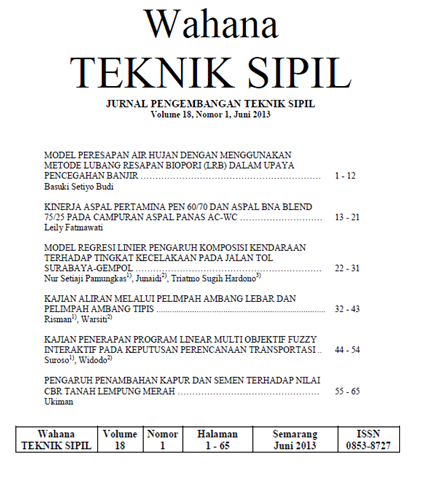Pemanfaatan Tanah Blangket Sebagai Bahan Campuran Paving Block Dengan Tinjauan Kuat Tekan
DOI:
https://doi.org/10.32497/wahanats.v18i2.983Keywords:
paving block, blangket soil, compressive strength, compositionAbstract
In today's society infrastructure development , especially in the field of housing and there's also a supporting infrastructure utilization and the use of paving blocks as a construction material . This is because the use of paving blocks are generally considered less expensive and easy execution. Blangket soil can be categorized as one of the kinds of soils containing lime , which is the precipitate formed by chemical processes or mechanisms in nature ( BKPM Technology of Materials 2 ; 2002) . Blangket soil has physical characteristics such as clay or loose, white or dull yellow. This soil is found in the area Grobogan . This study tried to assess the use of the material as a mixture of blangket soil making paving blocks in terms of compressive strength. This study used an experimental method in the laboratory testing of materials POLINES Civil Engineering department, where for each of the mixtures made 3 test object. The test results indicate that the material can be used as an alternative blangket soil as a mixture of block paving to reduce and replace the use of sand material . It is shown from the results of testing compressive strength of paving blocks with a mixture of soil blangket in comparison 1PC : 4Ps : 2TB has a compressive strength of 10.75 MPa , which qualified quality block paving D ( SNI 03-0691-1996 use for a garden ). For future development needs to be done further research on the use of land blangket as material for paving blocks in terms of economics.
Downloads
Published
Issue
Section
License
Authors who publish with this journal agree to the following terms:Authors retain copyright and grant the journal right of first publication with the work simultaneously licensed under a Creative Commons Attribution License that allows others to share the work with an acknowledgement of the work's authorship and initial publication in this journal.
Authors are able to enter into separate, additional contractual arrangements for the non-exclusive distribution of the journal's published version of the work (e.g., post it to an institutional repository or publish it in a book), with an acknowledgement of its initial publication in this journal.
Authors are permitted and encouraged to post their work online (e.g., in institutional repositories or on their website) prior to and during the submission process, as it can lead to productive exchanges, as well as earlier and greater citation of published work (See The Effect of Open Access).






